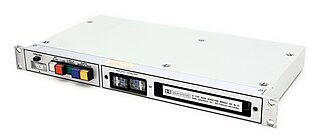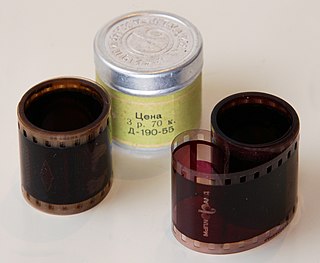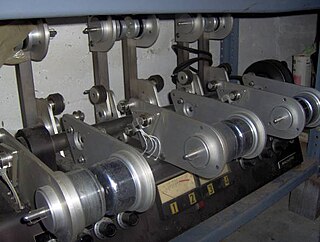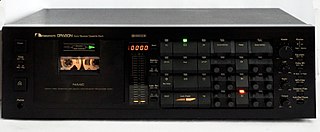Overview
These tones are included in the audible main portion of audio in the case of satellite; on tape, these often are filtered. Normally, subaudible tones are at one of the following frequencies: 25, 35, 50, 75 hertz (Hz), or combinations of those frequencies. Until computerized radio automation became inexpensive and common, 25 and 35 Hz were used either in the audio stream or, in the case of tape cartridges used in radio broadcasting (better known as "carts"), on a special track on the tape to indicate to a radio station's automation system that it was time to trigger another event.
With the advent of computers and digital satellite, these tones are relegated to triggering commercial announcements and legal IDs on a dwindling number of radio networks, as tones in the audio have been supplanted by external data channels sent independent of audio on digital satellite feeds for radio. These trigger relay closure terminals on the satellite receiver itself (Starguide being a prominent system).

A Dolby noise-reduction system, or Dolby NR, is one of a series of noise reduction systems developed by Dolby Laboratories for use in analog audio tape recording. The first was Dolby A, a professional broadband noise reduction system for recording studios in 1965, but the best-known is Dolby B, a sliding band system for the consumer market, which helped make high fidelity practical on cassette tapes, which used a relatively noisy tape size and speed. It is common on high-fidelity stereo tape players and recorders to the present day, although Dolby has as of 2016 ceased licensing the technology for new cassette decks. Of the noise reduction systems, Dolby A and Dolby SR were developed for professional use. Dolby B, C, and S were designed for the consumer market. Aside from Dolby HX, all the Dolby variants work by companding: compressing the dynamic range of the sound during recording, and expanding it during playback.
A cassette deck is a type of tape machine for playing and recording audio cassettes that does not have a built-in power amplifier or speakers, and serves primarily as a transport. It can be a part of an automotive entertainment system, a part of a portable mini system or a part of a home component system. In the latter case it is also called a component cassette deck or just a component deck.
Sound can be recorded and stored and played using either digital or analog techniques. Both techniques introduce errors and distortions in the sound, and these methods can be systematically compared. Musicians and listeners have argued over the superiority of digital versus analog sound recordings. Arguments for analog systems include the absence of fundamental error mechanisms which are present in digital audio systems, including aliasing and quantization noise. Advocates of digital point to the high levels of performance possible with digital audio, including excellent linearity in the audible band and low levels of noise and distortion.

A blue box is an electronic device that produces tones used to generate the in-band signaling tones formerly used within the North American long-distance telephone network to send line status and called number information over voice circuits. This allowed an illicit user, referred to as a "phreaker", to place long-distance calls, without using the network's user facilities, that would be billed to another number or dismissed entirely as an incomplete call. A number of similar "color boxes" were also created to control other aspects of the phone network.
A subcarrier is a sideband of a radio frequency carrier wave, which is modulated to send additional information. Examples include the provision of colour in a black and white television system or the provision of stereo in a monophonic radio broadcast. There is no physical difference between a carrier and a subcarrier; the "sub" implies that it has been derived from a carrier, which has been amplitude modulated by a steady signal and has a constant frequency relation to it.

Audio system measurements are a means of quantifying system performance. These measurements are made for several purposes. Designers take measurements so that they can specify the performance of a piece of equipment. Maintenance engineers make them to ensure equipment is still working to specification, or to ensure that the cumulative defects of an audio path are within limits considered acceptable. Audio system measurements often accommodate psychoacoustic principles to measure the system in a way that relates to human hearing.
In telecommunications, Continuous Tone-Coded Squelch System or CTCSS is one type of in-band signaling that is used to reduce the annoyance of listening to other users on a shared two-way radio communication channel. It is sometimes referred to as tone squelch. It does this by adding a low frequency audio tone to the voice. Where more than one group of users is on the same radio frequency, CTCSS circuitry mutes those users who are using a different CTCSS tone or no CTCSS. It is sometimes referred to as a sub-channel, but this is a misnomer because no additional channels are created. All users with different CTCSS tones on the same channel are still transmitting on the identical radio frequency, and their transmissions interfere with each other; however; the interference is masked under most conditions. The CTCSS feature also does not offer any security.

dbx is a family of noise reduction systems developed by the company of the same name. The most common implementations are dbx Type I and dbx Type II for analog tape recording and, less commonly, vinyl LPs. A separate implementation, known as dbx-TV, is part of the MTS system used to provide stereo sound to North American and certain other TV systems. The company, dbx, Inc., was also involved with Dynamic Noise Reduction (DNR) systems.
Broadcast automation incorporates the use of broadcast programming technology to automate broadcasting operations. Used either at a broadcast network, radio station or a television station, it can run a facility in the absence of a human operator. They can also run in a live assist mode when there are on-air personnel present at the master control, television studio or control room.

The filmstrip is a form of still image instructional media, once widely used by educators in primary and secondary schools (K-12) and for corporate presentations. It was largely made obsolete by the late 1980s by newer and increasingly lower-cost full-motion videocassettes and later on by DVDs. From the 1920s to the 1980s, filmstrips provided an easy and less expensive alternative to full motion educational films, requiring little storage space and being very quick to rewind for the next use. Filmstrips were durable and rarely needed splicing. They are still used in some areas.
Transtar was the first radio network to provide 24-hour music programming to local affiliates. The slate of 24-hour networks is now owned by Westwood One and operated by Dial Global. The studios are located in Valencia, California.

Sound recording and reproduction is the electrical, mechanical, electronic, or digital inscription and re-creation of sound waves, such as spoken voice, singing, instrumental music, or sound effects. The two main classes of sound recording technology are analog recording and digital recording.

A loop bin duplicator is a specialized audio tape machine used in the duplication of pre-recorded audio cassettes and 8-track cartridges.
Measurement of wow and flutter is carried out on audio tape machines, cassette recorders and players, and other analog recording and reproduction devices with rotary components This measurement quantifies the amount of 'frequency wobble' present in subjectively valid terms. Turntables tend to suffer mainly slow wow. In digital systems, which are locked to crystal oscillators, variations in clock timing are referred to as wander or jitter, depending on speed.
The history of sound recording - which has progressed in waves, driven by the invention and commercial introduction of new technologies — can be roughly divided into four main periods:
In a conventional, analog two-way radio system, a standard radio has noise squelch or carrier squelch, which allows a radio to receive all transmissions. Selective calling is used to address a subset of all two-way radios on a single radio frequency channel. Where more than one user is on the same channel, selective calling can address a subset of all receivers or can direct a call to a single radio. Selective calling features fit into two major categories—individual calling and group calling. Individual calls generally have longer time-constants: it takes more air-time to call an individual radio unit than to call a large group of radios.
In digital audio, 44,100 Hz is a common sampling frequency. Analog audio is often recorded by sampling it 44,100 times per second, and then these samples are used to reconstruct the audio signal when playing it back.
A reed receiver or tuned reed receiver (US) was a form of multi-channel signal decoder used for early radio control systems. It uses a simple electromechanical device or 'resonant reed' to demodulate the signal, in effect a receive-only modem. The encoding used is a simple form of frequency-shift keying.

Electric music technology refers to musical instruments and recording devices that use electrical circuits, which are often combined with mechanical technologies. Examples of electric musical instruments include the electro-mechanical electric piano, the electric guitar, the electro-mechanical Hammond organ and the electric bass. All of these electric instruments do not produce a sound that is audible by the performer or audience in a performance setting unless they are connected to instrument amplifiers and loudspeaker cabinets, which made them sound loud enough for performers and the audience to hear. Amplifiers and loudspeakers are separate from the instrument in the case of the electric guitar, electric bass and some electric organs and most electric pianos. Some electric organs and electric pianos include the amplifier and speaker cabinet within the main housing for the instrument.

The Nakamichi Dragon is an audio cassette deck that was introduced by Nakamichi in 1982 and marketed until 1994. The Dragon was the first Nakamichi model with bidirectional replay capability and the world's first production tape recorder with an automatic azimuth correction system; this feature, which was invented by Philips engineers and improved by Niro Nakamichi, continuously adjusts the azimuth of the replay head to minimize apparent head skew and correctly reproduce the treble signal present on the tape. The system allows the correct reproduction of mechanically skewed cassettes and recordings made on misaligned decks. Apart from the Dragon, similar systems have only been used in the Nakamichi TD-1200 car cassette player and the Marantz SD-930 cassette deck.








